3000 BC: Dust Abacus
Dust abacus is invented, probably in Babylonia.
1800 BC: Algorithms
Babylonian mathematician develops algorithms to resolve numerical problems.
500 BC: Bead and Wire Abacus
Originated in Egypt.
200 AD: Computing Tray
Saun-pan computing tray is used in China; soroban computing tray used in Japan.
1000: Modern Abacus
 Gerbert of Aurillac or Pope Sylvester II devises a more efficient abacus.
Gerbert of Aurillac or Pope Sylvester II devises a more efficient abacus.
1502: Watch
 Peter Henlein, a craftsman from Nuremberg Germany, creates the first watch.
Peter Henlein, a craftsman from Nuremberg Germany, creates the first watch.
1600: Electricity
 William Gilbert coins the term electricity from the Greek word elecktra.
William Gilbert coins the term electricity from the Greek word elecktra.
1617: Napier's Bones
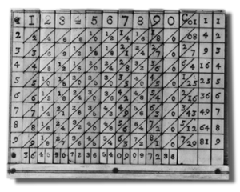 |
John Napier introduced a system called Napier's Bones, made from horn, bone or ivory the device allowed the capability of multiplying by adding numbers and dividing by subtracting.
|
1622: Slide Rule

 William Oughtred develops the slide rule in England.
William Oughtred develops the slide rule in England.
1624: Calculator-Clock
 Wilhelm Schickard builds first four-function calculator-clock at the University of Heidelberg.
Wilhelm Schickard builds first four-function calculator-clock at the University of Heidelberg.
1642: Numerical Calculator
 Blaise Pascal builds the first numerical calculating machine in Paris.
Blaise Pascal builds the first numerical calculating machine in Paris.
1673: Mechanical Calculator
 Gottfried Leibniz builds a mechanical calculating machine that multiplies, divides, adds and subtracts.
Gottfried Leibniz builds a mechanical calculating machine that multiplies, divides, adds and subtracts.
1769: Steam Engine
|
|
Steam engines were the first engine type to see widespread use. They were first invented by Thomas Newcomen in 1705, and James Watt (who we remember each time we talk about "60-watt light bulbs" and the such) made big improvements to steam engines in 1769. Steam engines powered all early locomotives, steam boats and factories, and therefore acted as the foundation of the Industrial Revolution. You can argue that steam engines aren't really a part of the history of IT, but... it is such a major technological advance that it makes the modern combustion engine look like a mere upgrade. The steam engine is simply too big to ignore when talking about the history of technology.
|
1780: Electricity
 Benjamin Franklin discovers electricity.
Benjamin Franklin discovers electricity.
1805: Punch Cards
 Joseph-Marie Jacquard invents perforated card for use on his loom.
Joseph-Marie Jacquard invents perforated card for use on his loom.
1820: Calculator
 Thomas de Colmar creates the first reliable, useful and commercially successful calculating machine.
Thomas de Colmar creates the first reliable, useful and commercially successful calculating machine.
1822: Difference Engine
 In England Charles Babbage designs a Difference Engine to calculate logarithms, but the machine is never built.
In England Charles Babbage designs a Difference Engine to calculate logarithms, but the machine is never built.
1827: Ohm's Law
 George Simon Ohm introduces Ohm's law in the book Die galvanische Kette, mathematisch bearbeitet.
George Simon Ohm introduces Ohm's law in the book Die galvanische Kette, mathematisch bearbeitet.
1831: Telegraph
 Joseph Henry of Princeton invents the first working telegraph.
Joseph Henry of Princeton invents the first working telegraph.
1833: Analytical Machine
 Charles Babbage designs the Analytical Machine that follows instructions from punched-cards. It is the first general purpose computer.
Charles Babbage designs the Analytical Machine that follows instructions from punched-cards. It is the first general purpose computer.
1838: Morse Code
 Samuel Morse invents a code (later called Morse code) that used different numbers to represent the letters of the English alphabet and the then digits.
Samuel Morse invents a code (later called Morse code) that used different numbers to represent the letters of the English alphabet and the then digits.
1842: First Program
 Lady Ada Byron, Countess of Lovelace and daughter of Lord Byron, the poet, documents Babbage's work and writes programs for Babbage.
Lady Ada Byron, Countess of Lovelace and daughter of Lord Byron, the poet, documents Babbage's work and writes programs for Babbage.
1851: Western Union
 Founded 1851, the first transcontinental telegraph line in 1861, the first stock ticker in 1866, the money transfer service in 1871, the first charge card for consumers in 1914, teletypewriters in 1923, intercity fax in 1935, intercity microwave communications in 1943.
Founded 1851, the first transcontinental telegraph line in 1861, the first stock ticker in 1866, the money transfer service in 1871, the first charge card for consumers in 1914, teletypewriters in 1923, intercity fax in 1935, intercity microwave communications in 1943.
Western Union was also the first American telecommunications corporation to maintain its own fleet of geosynchronous communication satellites starting in 1974.
1854: Boolean Algebra
 George Boole publishes The Mathematical Analysis of Logic using the binary system now known as Boolean algebra.
George Boole publishes The Mathematical Analysis of Logic using the binary system now known as Boolean algebra.
1855: Mechanical Computer
George and Edvard Scheutz of Stockholm build the first practical mechanical computer based on Babbages work.
1866: Trans-Alantic Cable
The first successful Trans-Atlantic cable is laid from Ireland to Newfoundland.
1868: Typewriter
Christopher Sholes invents the typewriter in the United States utilizing the QWERTY keyboard.
1875: Toshiba
 Tanaka Seizo-sho is established in Japan and later merges with another company called shibaura Seisaku-sho to form Tokyo Shibarura Denki. Later this company's name is shortened to the company that we know today, Toshiba.
Tanaka Seizo-sho is established in Japan and later merges with another company called shibaura Seisaku-sho to form Tokyo Shibarura Denki. Later this company's name is shortened to the company that we know today, Toshiba.
1876: Telephone
 Invented by Alexander Graham Bell.
Invented by Alexander Graham Bell.
|
1877: AT&T
 |
Bell Telephone was renamed American Telephone and Telegraph Company in 1885. AT&T not only created the first public communication network, they created Bell Labs in 1925.
|
1877: Microphone
The microphone is invented in the United States by Emile Berliner.
1883: Edison Effect
American Thomas Edison discovers the Edison effect, in which a electric current flows through a vacuum.
1884: punch-card tabulating machine
 Herman Hollerith applies for patents for automatic punch-card tabulating machine.
Herman Hollerith applies for patents for automatic punch-card tabulating machine.
1884: Institute of Electrical Engineers (IEE) is founded.

1886: Adding Machine
 William Burroughs develops the first commercially successful mechanical adding machine.
William Burroughs develops the first commercially successful mechanical adding machine.
1897: Cathode-Ray Oscilloscope
German scientist Karl Ferdinand Braun invents the Cathode-Ray Oscilloscope.
1888: A/C
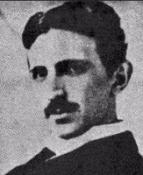 |
Nikola Tesla, the genius known as the wild man of electronics, was possibly the greatest technical mind of the human race. Tesla invented the rotating field motor, an alternating-current generator that provides your light and electricity, the transformer through which it is sent, and even the high voltage coil of your picture-tube. The Tesla Coil, in fact, is used in radios, television sets, and a wide-range of other electronic equipment, since 1891. Tesla designed an oscillator that generated half a million volts, the radio, vacuum tubes, X-rays, hydroelectric generators, the loudspeaker, fluorescent lights, radar, the rotary engine, generating microwaves, The basis for diathermy (deep heating tissues through the use of high frequency electrical current), and remote radio control. Among his notes were ideas for Missiles, Particle beam weaponry, Satellites, Nuclear fission, and Robots.
|
1889: Tabulating Machine Company
1889, a patent is issued for Hollerith tabulating machine. In 1896 Herman Hollerith starts the Tabulating Machine Company, the company later becomes the well-known computer company IBM.
1890: Punch card counter
Dr. Herman Hollerith constructs an electromechanical machine using perforated cards for use in the U.S. census.
1901: First Trans Atlantic Broadcast
The first radio message is sent across the Atlantic Ocean in Morse code.
1903: Logic Gates
Nikola Tesla patents electrical logic circuits called gates or switches.
1906: Vacuum Tube
 |
 |
Lee De Forest developed a triode in a vacuum tube, which amplified electrical currents. |
1911: IBM



|
|
Charles R. Flint arranges the merger of the International Time Recording Company, Computing Scale Company, and the Tabulating Machine Company to form the Computing-Tabulating-Recording Company (C-T-R). The new company is based in New York City and has 1,300 employees. George Fairchild becomes the first chairman of the board of directors. C-T-R will be renamed International Business Machines Corporation in 1924.
|
1912: Institute of Radio Engineers (IRE) is formed.
1920: Radio Broadcasting
First radio broadcasting begins in United States, Pittsburgh, PA.
1921: Robot
The word robot is used to describe mechanical workers in the play R.U.Robotics by Karel Capek.
1921: The first Radio Shack store is open.

1924: IBM
Computing-Tabulating-Recording Company changes its name to International Business Machines.
1925: Differential Analyzer
 Vannevar Bush, builds a large scale analog calculator, the differential analyzer, at MIT.
Vannevar Bush, builds a large scale analog calculator, the differential analyzer, at MIT.
1925: Bell Labs
 |
The research and development section of AT&T. Scientists at Bell invent the transistor, the laser, the solar cell, communications satellites, the first transistorized computer, and over 26,000 patents and eleven Nobel Prize winners.
Bell Labs is now the research and development section of Lucent Technologies.
|
1927: TV
First public demonstration of television. Radio-telephone becomes operational between London and New York.
1928: CRT
 A Russian immigrant, Vladimir Zworykin, invents the cathode ray tube (CRT).
A Russian immigrant, Vladimir Zworykin, invents the cathode ray tube (CRT).
1928: Galvin/Motorola
 |
 Founded by Paul and Joseph Galvin to market a device that allows battery-powered radios to run on A/C current. In 1947, they change their name to Motorola, Inc. to match that of the company's 1930 car radio. Motorola comes from linking "motor" with the suffix "ola" (sound). They eventually become one of the world's top processor developers.
Founded by Paul and Joseph Galvin to market a device that allows battery-powered radios to run on A/C current. In 1947, they change their name to Motorola, Inc. to match that of the company's 1930 car radio. Motorola comes from linking "motor" with the suffix "ola" (sound). They eventually become one of the world's top processor developers.
|
1931: Z1

First electronic calculator, the Z1, is built in Germany by Konrad Zuse.
1933: Voder
First electronic talking machine, the Voder, is built by Dudley, who follows in 1939 with the Vocoder (Voice coder).
1934: The FCC is established.

1934: The US Communication Act goes into place.
1936: Dvorak keyboard developed.
1936: "On Computable Number's"
 |
 |
Alan Turing, while at Princeton University, writes "On Computable Number's", which details a programmable computer he called a "Turing Machine".
|
1937: Binary Calculator
 George Stibitz builds the first binary calculator at Bell Telephone Laboratories.
George Stibitz builds the first binary calculator at Bell Telephone Laboratories.
1939: Radio Shack
 First Radio Shack catalog is published.
First Radio Shack catalog is published.
1939: HP
 |
Stanford University classmates Bill Hewlett and Dave Packard founded HP in 1939. The company's first product, built in a Palo Alto garage, was an audio oscillator, an electronic test instrument used by sound engineers. One of HP's first customers was Walt Disney Studios, which purchased eight oscillators to develop and test an innovative sound system for the movie Fantasia.
|
1939: First Digital Computer?
John J. Atanasoff designs a prototype for the ABC (Atanasoff-Berry Computer) with the help of graduate student Clifford Berry at Iowa State College. In 1973 a judge ruled it the first automatic digital computer.
1940: First Digital Computer?
At Bell Labs, George Stibitz demonstrates the Complex Number Calculator, which may be the first digital computer.
1940: First color TV broadcast.
1943: Colossus

|
Created by Max Newman and Alan Turing for the British Government. Although this was the first electronic computer, it was designed to crack the German's code machine Enigma during World War I, so it was held top secret until long after the ENIAC was introduced to the world.
|
1943: Walkie-Talkie
Dan Noble with Motorola designs a "Walkie Talkie" the first portable FM two-way radio that a backpack version that weighed 35 pounds.
1944: IBM Mark I
The Automatic Sequence Controlled Calculator, also called the Mark I, was completed in 1944 after six years of development with Harvard University. It was the first machine that could execute long computations automatically.
1945: ENIAC

|
Electric Numberical Integrator and Computer, the world's first commercial electronic digital computer, a machine built by John Mauchly and J. Presper Eckert at the University of Pennsylvania's Moore School of Engineering, to calculate ballistic firing tables for the US Army during World War II. It was programmed using switches and cables into plug boards. Speed 5,000 operations per second, Floor space: 1,000 square feet. There were computers and concepts that pre-dated the ENIAC. Charles Babbage's Analytical Engine in 1822 and Ada Lovelace's programming techniques for it were a big influence. Herman Hollerith's Tabulator for the 1890 US census, Konrd Zuse's Z3 in 1941, and Harvard University's Howard Aiken and IBM's Mark I, also pre-dated the ENIAC, but non of these were electronic computers. The Colossus was not yet known to the world and was for military use only, so the ENIAC represents the beginning of the Computer industry.
|
1945: Satellite conceptualized
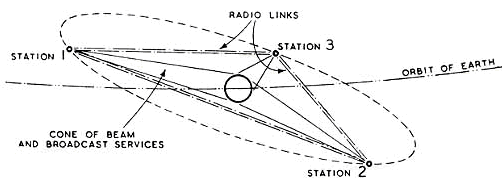 |
Arthur C. Clarke publishes the concept of the geosychronous orbit communications satellite in Wireless World. |
1946: AVIDAC
 |
University of Pennsylvania's Moore School of Electrical Engineering stimulated construction of stored-program computers at universities and research institutions. This free, public set of lectures inspired the EDVAC, EDSAC, BINAC, and, later, IAS machine clones like the AVIDAC.
|
1946: Cathode-Ray Tube
F.C. Williams applies for a patent on his cathode-ray tube (CRT) storing device, an original form of random-access memory (RAM).
1947: ISO
 ISO is a worldwide federation of national
standards bodies from some 140 countries.
ISO is a worldwide federation of national
standards bodies from some 140 countries.
1947: Artificial Intelligence
Alan M. Turing publishes an article on Intelligent Machinery which launches artificial intelligence.
1948: SSEC

|
Selective Sequence Electronic Calculator by IBM, computed scientific data in public display near the company's Manhattan headquarters. Before its decommissioning in 1952, the SSEC produced the moon-position tables used for plotting the course of the 1969 Apollo flight to the moon.
|
1948: Manchester Mark I
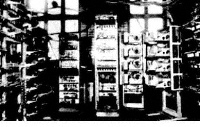 |
Max Newman ran the world's first stored program. It functioned as a complete system using the Williams tube for memory. This University machine became the prototype for Ferranti Corp.'s first computer. Add time: 1.8 microseconds, Input/output: paper tape, teleprinter, switches, Memory size: 128 + 1024 40-digit words, Memory type: cathode ray tube, magnetic drum, Technology: 1,300 vacuum tubes, Floor space: medium room, Project leaders: Frederick Williams and Tom Kilburn.
|
1948: 604
The 604 multiplying punch, based upon the vacuum tube technology, is produced by IBM.
1948: Transistor
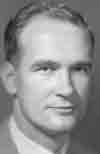 |
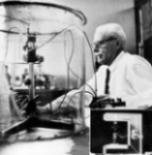 |
 |
 |
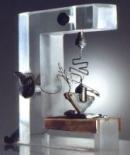 |
William (Bill) Shockley, Walter Brattain, John Bardeen at Bell Labs create a semiconductor based electric current amplifier. The name "transistor" combines "trans-resistance" with the names of other electroic devices like thermistors.
|
1949: EDSAC
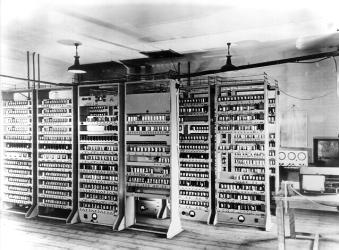 |
Electronic Delay Storage Automatic Computer by Maurice Wilkes, the first practical stored-program computer, at Cambridge University. For programming the EDSAC, Wilkes established a library of short programs called subroutines stored on punched paper tapes. Processed with vacuum tubes, memory with mercury delay line at a speed of 714 operations per second.
|
1949: Whirlwind
 |
Jay Forrester uses iron cores as main memory in Whirlwind. MIT debuted on Edward R. Murrow's "See It Now" television series in 1951. Project director Jay Forrester described the computer as a "reliable operating system," running 35 hours a week at 90-percent utility using an electrostatic tube memory. Forrester patent is issued in 1956.
|
1949: Chess Machine
Claude Shannon of MIT builds the first chess playing machine.
1949: SSEM
The small-scale electronic machine (SSEM) is fully operational at Manchester University.
1950: Electronic Computer
The first electronic computer is created in Japan by Hideo Yamachito.
1950: Magnetic Storage, ERA 1101
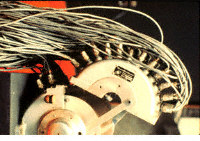 |
Engineering Research Associates of Minneapolis built the ERA 1101, the first commercially produced computer; the company's first customer was the U.S. Navy. It held 1 million bits on its magnetic drum, the earliest magnetic storage devices. Drums registered information as magnetic pulses in tracks around a metal cylinder. Read/write heads both recorded and recovered the data. Drums eventually stored as many as 4,000 words and retrieved any one of them in as little as five-thousandths of a second.
|
1950: SEAC
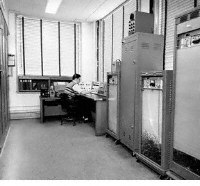 |
Standards Eastern Automatic Computer by The National Bureau of Standards, constructed the system in Washington as a laboratory for testing components and systems for setting computer standards. The SEAC was the first computer to use all-diode logic, a technology more reliable than vacuum tubes, and the first stored-program computer completed in the United States. Magnetic tape in the external storage units (shown on the right of this photo) stored programming information, coded subroutines, numerical data, and output.
|
1950: SWAC
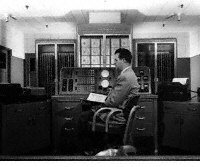 |
Standards Western Automatic Computer by The National Bureau of Standards, completed the system at the Institute for Numerical Analysis in Los Angeles. Rather than testing components like its companion, the SEAC, the SWAC had an objective of computing using already-developed technology.
|
1950: Pilot ACE
 |
Automatic Computing Engine by Alan Turing and the National Physical Laboratory in Great Britain.
|
1951: First Joint Computer Conference is held.
1951: Microprogramming
 Maurice V. Wilkes introduces the concept of microprogramming.
Maurice V. Wilkes introduces the concept of microprogramming.
1951: IEEE Computer Society is formed.

1951: LEO
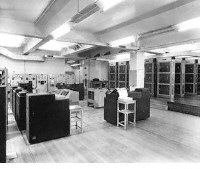 |
England's first commercial computer, the Lyons Electronic Office (LEO), solved clerical problems. The president of Lyons Tea Co. had the computer, modeled after the EDSAC, built to solve the problem of daily scheduling production and delivery of cakes to the Lyons tea shops. After the success of the first LEO, Lyons went into business manufacturing computers to meet the growing need for data processing systems.
|
1951: UNIVAC I
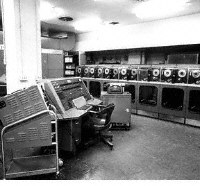 |
 |
This system Remington Rand delivered to the U.S. Census Bureau was the first commercial computer to attract widespread public attention & the first to use a compiler, the A-O, developed by Grace Hopper. With the A-O, "Coders" (calling them programmers had not yet left England) could now instruct the computer to retireve subroutines from storage (magnetic tape) to put into memory. Although manufactured by Remington Rand, the machine often was mistakenly referred to as the "IBM UNIVAC." Remington Rand eventually sold 46 machines at more than $1 million each.F.O.B. factory $750,000 plus $185,000 for a high speed printer. Speed: 1,905 operations per second, Input/output: magnetic tape, unityper, printer. Memory size: 1,000 12-digit words in delay lines, Memory type: delay lines, magnetic tape, Technology: serial vacuum tubes, delay lines, magnetic tape, Floor space: 943 cubic feet, Cost: F.O.B. factory $750,000 plus $185,000 for a high speed printer, Project leaders: J. Presper Eckert and John Mauchly
|
1952: IAS

|
John von Neumann's IAS computer became operational at the Institute for Advanced Studies in Princeton, N.J. Contract obliged the builders to share their designs with other research institutes. This resulted in a number of clones: The MANIAC at Los Alamos Scientific Laboratory, the ILLIAC at the University of Illinois, the Johnniac at Rand Corp., the SILLIAC in Australia, and others.
|
1953: IBM701

|
By International Business Machines. During three years of production, IBM sold 19 machines to research laboratories, aircraft companies, and the federal government.
|
1954: IBM650
 |
IBM 650 magnetic drum calculator established itself as the first mass-produced computer, with the company selling 450 in one year. Spinning at 12,500 rpm, the 650's magnetic data-storage drum allowed much faster access to stored material than drum memory machines.
|
1954: FORTRAN
 The first version of FORTRAN (formula translator) is published by IBM.
The first version of FORTRAN (formula translator) is published by IBM.
1954: CERN
 Established on September 29, 1954.
Established on September 29, 1954.
1955: Shockley Semiconductor
 |
 |
 |
Bill Shockley leaves Bell Labs after co-inventing the transistor, to create his own company in Palo Alto, California (to be near Stanford University). This marks the start of the Silicon Valley.
|
1955: Transistor Computer
Bell Labs introduces its first transistor computer. Transistors are faster, smaller and create less heat than traditional vacuum tubs, making these computers more reliable and efficient.
1956: TX-0

|
TX-0 by MIT, the first general-purpose, programmable computer built with transistors. For easy replacement, designers placed each transistor circuit inside a "bottle," similar to a vacuum tube. Constructed at MIT's Lincoln Laboratory, the TX-0 moved to the MIT Research Laboratory of Electronics, and got the attention of members from the Tech Model Railroad Club, where it hosted some early imaginative tests of programming, including a Western movie shown on TV, 3-D tic-tac-toe, and a maze in which mouse found martinis and became increasingly inebriated.
|
1956: 3005 RAMAC
IBM's 3005 RAMAC is the first computer to be shipped with a hard disk drive.
1957: Fairchild Semiconductor

|
Founded by eight disgruntled employees who left Shockley Semiconductor, Robert Noyce of Fairchild would invent the integrated circuit in 1961. Unfortunately for Fairchild, Jack Kilby of Texas Instruments also invented the integrated circuit at the same time. Although created independantly of each other, credit for the IC is now shared between the two companies.
|
1957: Digital Equipment Corporation
  Founded by Kenneth Olsen. The company will later become a major network computer manufacture.
Founded by Kenneth Olsen. The company will later become a major network computer manufacture.
1957: Sputnik
 Russia launches the first artificial satellite, named Sputnik.
Russia launches the first artificial satellite, named Sputnik.
1957: Casio established

1958: NASA
 The National Advisory Committee for Aeronautics is renamed to National Aeronautics and Space Administration.
The National Advisory Committee for Aeronautics is renamed to National Aeronautics and Space Administration.
1958: Satellite Transmission
President Eisenhower's Christmas address is the first voice transmission from a satellite.
1958: SAGE
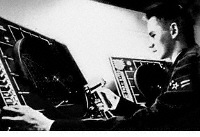 |
Semi-Automatic Ground Environment, linked hundreds of radar stations in the United States and Canada in the first large-scale computer communications network. An operator directed actions by touching a light gun to the screen. The air defense system operated on the AN/FSQ-7 computer (known as Whirlwind II during its development at MIT) as its central computer. Each computer used a full megawatt of power to drive its 55,000 vacuum tubes, 175,000 diodes and 13,000 transistors.
|
1958: NEAC 1101
 |
Japan's first electronic computer, by NEC.
|
1958: Algo
 |
Konrad Zuse begins developing ALGO 58 (Algorithmic Language) in Europe.
|
1958: FORTRAN II
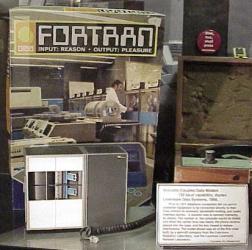 |
IBM releases an updated FORTRAN, Formula Translator II, programming language.
|
1959: 7000 Series
 |
 |
IBM's 7000 series mainframes were the company's first transistorized computers. At the top of the line of computers, all of which emerged significantly faster and more dependable than vacuum tube machines, sat the 7030, also known as the "Stretch." Nine of the computers, which featured a 64-bit word and other innovations, were sold to national laboratories and other scientific users. L. R. Johnson first used the term "architecture" in describing the Stretch.
|
1959: Time Sharing
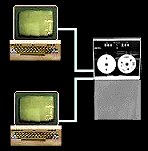 |
 |
Thomas Kurtz and John Kemeny of Dartmouth college gave their "Time Sharing" presentation to MIT. This gave detailed plans for multiple terminals to be connected to a computer that would share access.
|
1959: LISP



List Processing created by John McCarthy of MIT.
1959: Hitachi founded

1959: Transistor Radio
Motorola produces the two-way, fully transistorized mobile radio.
1959: Panasonic is founded.

|


 Gerbert of Aurillac or Pope Sylvester II devises a more efficient abacus.
Gerbert of Aurillac or Pope Sylvester II devises a more efficient abacus.
 Peter Henlein, a craftsman from Nuremberg Germany, creates the first watch.
Peter Henlein, a craftsman from Nuremberg Germany, creates the first watch.
 William Gilbert coins the term electricity from the Greek word elecktra.
William Gilbert coins the term electricity from the Greek word elecktra.


 William Oughtred develops the slide rule in England.
William Oughtred develops the slide rule in England.
 Wilhelm Schickard builds first four-function calculator-clock at the University of Heidelberg.
Wilhelm Schickard builds first four-function calculator-clock at the University of Heidelberg.
 Blaise Pascal builds the first numerical calculating machine in Paris.
Blaise Pascal builds the first numerical calculating machine in Paris.
 Gottfried Leibniz builds a mechanical calculating machine that multiplies, divides, adds and subtracts.
Gottfried Leibniz builds a mechanical calculating machine that multiplies, divides, adds and subtracts.
 Benjamin Franklin discovers electricity.
Benjamin Franklin discovers electricity.
 Joseph-Marie Jacquard invents perforated card for use on his loom.
Joseph-Marie Jacquard invents perforated card for use on his loom.
 Thomas de Colmar creates the first reliable, useful and commercially successful calculating machine.
Thomas de Colmar creates the first reliable, useful and commercially successful calculating machine.
 In England Charles Babbage designs a Difference Engine to calculate logarithms, but the machine is never built.
In England Charles Babbage designs a Difference Engine to calculate logarithms, but the machine is never built.
 George Simon Ohm introduces Ohm's law in the book Die galvanische Kette, mathematisch bearbeitet.
George Simon Ohm introduces Ohm's law in the book Die galvanische Kette, mathematisch bearbeitet.
 Joseph Henry of Princeton invents the first working telegraph.
Joseph Henry of Princeton invents the first working telegraph.
 Charles Babbage designs the Analytical Machine that follows instructions from punched-cards. It is the first general purpose computer.
Charles Babbage designs the Analytical Machine that follows instructions from punched-cards. It is the first general purpose computer.
 Samuel Morse invents a code (later called Morse code) that used different numbers to represent the letters of the English alphabet and the then digits.
Samuel Morse invents a code (later called Morse code) that used different numbers to represent the letters of the English alphabet and the then digits.
 Lady Ada Byron, Countess of Lovelace and daughter of Lord Byron, the poet, documents Babbage's work and writes programs for Babbage.
Lady Ada Byron, Countess of Lovelace and daughter of Lord Byron, the poet, documents Babbage's work and writes programs for Babbage.
 Founded 1851, the first transcontinental telegraph line in 1861, the first stock ticker in 1866, the money transfer service in 1871, the first charge card for consumers in 1914, teletypewriters in 1923, intercity fax in 1935, intercity microwave communications in 1943.
Founded 1851, the first transcontinental telegraph line in 1861, the first stock ticker in 1866, the money transfer service in 1871, the first charge card for consumers in 1914, teletypewriters in 1923, intercity fax in 1935, intercity microwave communications in 1943. George Boole publishes The Mathematical Analysis of Logic using the binary system now known as Boolean algebra.
George Boole publishes The Mathematical Analysis of Logic using the binary system now known as Boolean algebra.
 Tanaka Seizo-sho is established in Japan and later merges with another company called shibaura Seisaku-sho to form Tokyo Shibarura Denki. Later this company's name is shortened to the company that we know today, Toshiba.
Tanaka Seizo-sho is established in Japan and later merges with another company called shibaura Seisaku-sho to form Tokyo Shibarura Denki. Later this company's name is shortened to the company that we know today, Toshiba.
 Invented by Alexander Graham Bell.
Invented by Alexander Graham Bell.

 Herman Hollerith applies for patents for automatic punch-card tabulating machine.
Herman Hollerith applies for patents for automatic punch-card tabulating machine.

 William Burroughs develops the first commercially successful mechanical adding machine.
William Burroughs develops the first commercially successful mechanical adding machine.







 Vannevar Bush, builds a large scale analog calculator, the differential analyzer, at MIT.
Vannevar Bush, builds a large scale analog calculator, the differential analyzer, at MIT.

 A Russian immigrant, Vladimir Zworykin, invents the cathode ray tube (CRT).
A Russian immigrant, Vladimir Zworykin, invents the cathode ray tube (CRT).

 Founded by Paul and Joseph Galvin to market a device that allows battery-powered radios to run on A/C current. In 1947, they change their name to Motorola, Inc. to match that of the company's 1930 car radio. Motorola comes from linking "motor" with the suffix "ola" (sound). They eventually become one of the world's top processor developers.
Founded by Paul and Joseph Galvin to market a device that allows battery-powered radios to run on A/C current. In 1947, they change their name to Motorola, Inc. to match that of the company's 1930 car radio. Motorola comes from linking "motor" with the suffix "ola" (sound). They eventually become one of the world's top processor developers.




 George Stibitz builds the first binary calculator at Bell Telephone Laboratories.
George Stibitz builds the first binary calculator at Bell Telephone Laboratories.
 First Radio Shack catalog is published.
First Radio Shack catalog is published.





 ISO is a worldwide federation of national
standards bodies from some 140 countries.
ISO is a worldwide federation of national
standards bodies from some 140 countries.













 Maurice V. Wilkes introduces the concept of microprogramming.
Maurice V. Wilkes introduces the concept of microprogramming.







 The first version of FORTRAN (formula translator) is published by IBM.
The first version of FORTRAN (formula translator) is published by IBM.
 Established on September 29, 1954.
Established on September 29, 1954.






 Founded by Kenneth Olsen. The company will later become a major network computer manufacture.
Founded by Kenneth Olsen. The company will later become a major network computer manufacture.
 Russia launches the first artificial satellite, named Sputnik.
Russia launches the first artificial satellite, named Sputnik.

 The National Advisory Committee for Aeronautics is renamed to National Aeronautics and Space Administration.
The National Advisory Committee for Aeronautics is renamed to National Aeronautics and Space Administration.












